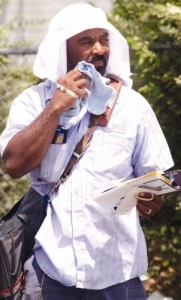Hot, and getting hotter
By Aaron Moore
Published in News on July 23, 2010 1:46 PM

News-Argus/BOBBY WILLIAMS
Goldsboro postal worker Blonza Davis tries to stay cool as he makes his rounds Thursday afternoon. By mid-afternoon the temperature reached the upper 90s with a heat index of 102.
With Goldsboro experiencing 99 percent humidity today, afternoon highs in the upper 90s and the heat index well past 100 degrees, folks in the Wayne County can officially say it's hot.
The day didn't take long to heat up, either. It was well past 80 degrees by 8 a.m. and nearing 90 by 9.
Brandon Vincent, a spokesman for the National Weather Service in Raleigh, said temperatures are "above normal," even for this time of year. But added that they are not completely out of the ordinary, or even unexpected.
"We just happen to be stuck in a pattern that's favorable for hot weather," he said.
Last month was the hottest June on record. On July 8, the National Weather Service recorded a high temperature of 103 degrees in Goldsboro.
The heat index for today, Vincent said, could reach up to 110 degrees in some parts of the eastern North Carolina region.
With the onslaught of hot weather, there is also a concern for those who might be susceptible to breathing problems or asthma attacks.
The Division of Air Quality in the North Carolina Department of Environmental and Natural Resources issues air quality alerts each day to let people know how pollutants in the air might react with the heat to create health hazards for at-risk people.
The main concern this time of year is ozone, said Tom Mather, a spokesman for the division.
Ozone, he said, is a mix of pollutants that react with heat and act as an irritant to skin and the respiratory tract, causing sore throats, infections and sometimes asthma attacks.
The Division of Air Quality releases alerts each day based on a color code from green to yellow, orange, red and purple.
Green is good, orange is above standard and purple is unhealthy and dangerous for everyone, Mather said.
Because ozone reacts with heat, however, Mather added if an alert is issued, people might still be safe going outside in the mornings before the day's heat has had time to build up.
For those who are called out into the heat because of their jobs, however, staying inside is not an option, and they have to take extra precautions to ensure their own safety.
"We send out e-mails almost daily to our superintendents and field staff reminding them to drink plenty of water, take breaks and stay cautious," said Stephanie Ross, who serves as president of general contractor D.S. Simmons.
The staff changed its hours at the beginning of the summer, she said, starting work earlier in the morning and incorporating more breaks to avoid the hottest part of the day.
"It's really dictated by the individual job schedules," she said, adding that those workers who are on inside renovation jobs have not had to change their schedules at all.
Scott Edwards of Cox-Edwards Co., also a general contractor, also said the company's employees have been starting work an hour earlier to avoid the worst of the heat, but that they are still working the same length of time.
Fortunately for those who have to be outside, however, Vincent said there are chances for rain Monday and Tuesday, which will bring in a northern cold front that will cool things down for a while.
